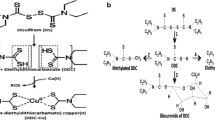Summary
A novel nitrosourea, 1-(2-chloroethyl)-3-[2-(dimethylaminosulfonyl)ethyl]-1-nitrosourea (TCNU) has been investigated with respect to cytotoxic mechanisms in rat and human cell lines which either posses (Mer+) or lack (Mer-) 06-alkylguanine transferase activity. TCNU produced significantly greater cytotoxicity in the Mercells (Walker 256 rat breast carcinoma resistant to nitrogen mustards; human lung carcinoma A427) than in the Mer+ cells (Walker 256 wild-type; human lung carcinoma A594). This correlated with results generated by alkaline elution studies which showed that TCNU caused DNA interstrand crosslinks in A427 but not in A549 cells. Inhibition of glutathione reductase activity by TCNU demonstrated that in carbamoylating activity the drug was intermediate between chlorozotocin and 1,(2-chloroethyl)-3-cyclohexyl-1-nitrosourea (CCNU) in both A427 and A549 cells. These data suggest that the presence of taurine in the drug structure does little to alter the cytotoxicity or the alkylating or carbamoylating properties of TCNU, and that any clinical advantages with TCNU will be the consequence of other factors.
Similar content being viewed by others
References
Babson JR, Reed DJ (1978) Inactivation of glutathione reductase by 2-chloroethyl nitrosourea derived isocyanates. Biochem Biophys Res Commun 83:754–762
Baskin SI, Wakayama K, Knight T (1982) The sulfur-containing amino acid pathway in normal and malignant cell growth. In: Huxtable RJ, Morales HP (eds) Taurine in nutrition and neurology. Plenum, New York pp 127–141
Christensen HN, Hess B, Riggs TR (1954) Concentration of taurine, β-alanine and triodothyronine by ascites carcinoma cells. Cancer Res 14:124–127
Dean SW, Gibson NW, Tew KD (1986) Selection of nitrogen mustard resistance in a rat tumor cell line results in loss of guanine 06-alkyl transferase activity. Mol Pharmacol 30: 77–80
Erickson LC, Bradley MO, Ducore JM, Ewig RA, Kohn KW (1980) DNA crosslinking and cytotoxicity in normal and transformed human cells treated with antitumor nitrosoureas. Proc Natl Acad Sci USA 77:467–471
Hammer CF, Loranger RA, Schein PS (1981) The structures and decomposition products of chlorozotocin: new intramolecular carbamates of 2-amino-2-deoxyhexoses. J Org Chem 46:1521–1531
Ishidate M, Sakurai Y, Izums M (1955) N-Bis-(β-chloroethyl) amino acids and related compounds as tumor growth retarding agents. J Am Pharm Assoc [sci Ed] 44:132–135
Kohn KW, Ewig RAG, Erickson LC, Zwelling LA (1981) Measurement of strand breaks and crosslinks by alkaline elution. In: Fredberg EC, Hanawalt PC (eds) DNA repair, a laboratory manual of research procedures, vol 1. Dekker, New York, pp 379–401
Mize CE, Langdau RG (1962) Hepatic gluthione reductase: I. Purification and general kinetic properties. J Biol Chem 237:1589–1595
Pierson HF, Fisher JM, Rabinovitz M (1985) Modulation by taurine of the toxicity of taumustine, a compound with antitumor activity. JNCI 75:905–909
Smith AC, Boyd MR (1984) Preferential effects of 1,3-bis(2-chloroethyl)-1-nitrosoureas (BCNU) on pulmonary glutathione reductase and glutathione/gluthione disulfide ratios: possible implications for lung toxicity. J Pharmacol Exp Ther 229:658–663
Smyth J, Warrington P, Cornbleet M, Leonard R, Wahlby S, Asp B, Gunnarsson PO, Polacek J (1985) Phase I trial of a novel nitrosourea — TCNU. Proc ECCO 3:7
Tallan HH, Jacobson E, Wright CE (1983) Taurine uptake by cultured human lymphoblastoid cells. Life Sci 33:1853–1860
Tew KD, Wang AL (1982) Selective toxicity of haloethylnitrosoureas in a carcinoma cell line resistant to bifunctional alkylating agents. Mol Pharmacol 21:729–738
Tew KD, Kyle G, Johnson A, Wang AL (1985) Carbamoylation of glutathione reductase and changes in cellular and chromosome morphology in a rat cell line resistant to nitrogen mustards but collaterally sensitive to nitrosoureas. Cancer Res 45:2326–2333
Tokunaga H, Yoneda Y, Kuriyama K (1979) Protective actions of taurine against streptozotocin-induced hyperglycemia. Biochem Pharmacol 28:2807–2811
Vibe-Petersen J, Bork E, Moller H, Hansen HH, Cornbleet M, Smyth J (1986) Early clinical experience with TCNU — a new water-soluble nitrosourea compound. Proc Am Soc Clin Oncol 5:31
Wakayama K, Besa EC, Baskin SI (1983) Changes in intracellular taurine content of human leukemic cells. Nagoya J Med Sci 45:89–96
Author information
Authors and Affiliations
Additional information
This work was supported by a grant from the Helsingborg Research Foundation
Rights and permissions
About this article
Cite this article
Tew, K.D., Dean, S.W. & Gibson, N.W. The effect of a novel taurine nitrosourea, 1-(2-chloroethyl)-3-[2-(dimethylaminosulfonyl)ethyl]-1-nitrosourea (TCNU) on cytotoxicity, DNA crosslinking and glutathione reductase in lung carcinoma cell lines. Cancer Chemother. Pharmacol. 19, 291–295 (1987). https://doi.org/10.1007/BF00261475
Received:
Accepted:
Issue Date:
DOI: https://doi.org/10.1007/BF00261475




